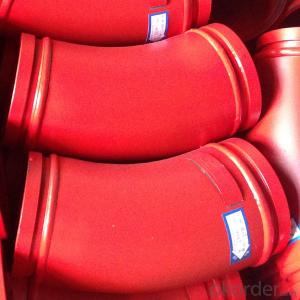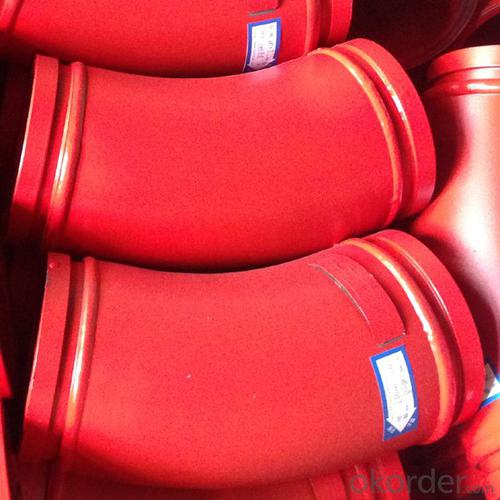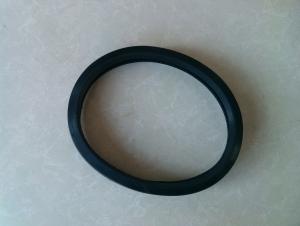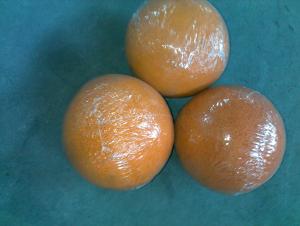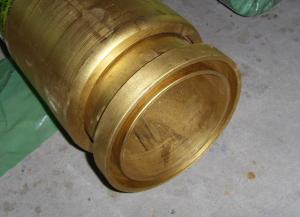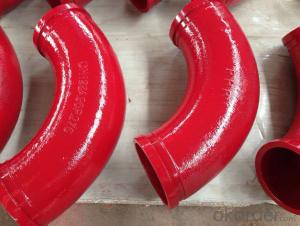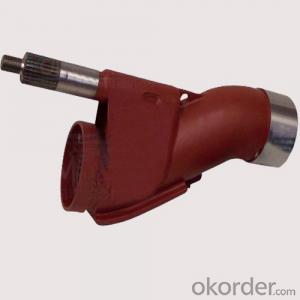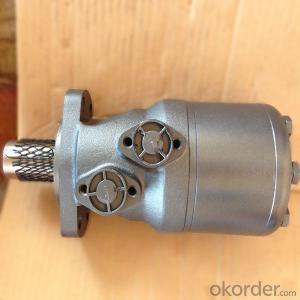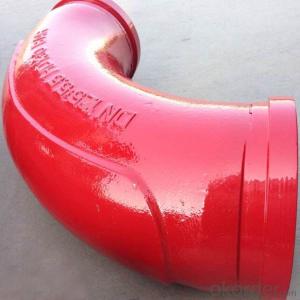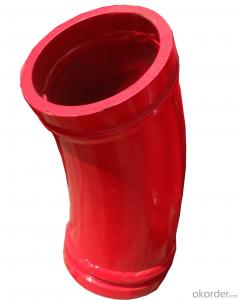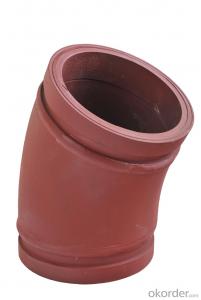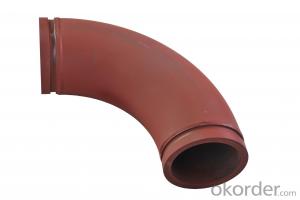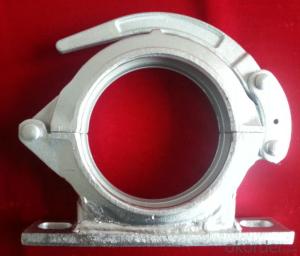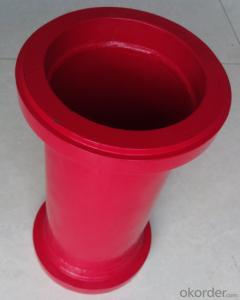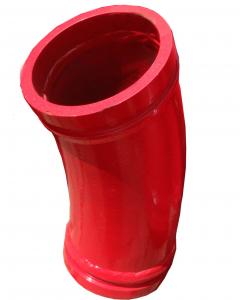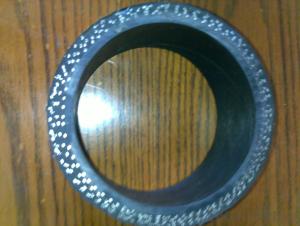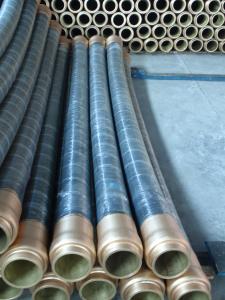Concrete Pumps Spare Parts Elbow Double Wall 45DEG R275
- Loading Port:
- Tianjin
- Payment Terms:
- TT OR LC
- Min Order Qty:
- 20 pc
- Supply Capability:
- 1000 pc/month
OKorder Service Pledge
OKorder Financial Service
You Might Also Like
Product Description:
The Concrete Pumps Spare Parts Elbow45DEG R275 Double Wall normally made by special MN13-4, to make sure the quanlity of elbows according to customer’s requests we usually keep the content of MN strictly over 15%, it will have a longer life as well, package will be in plywood box or cartons and put into container.
Scope of Application of the Goods
The Concrete Pumps Spare Parts Elbow 45DEG R275 Double Wall is a concrete pumps parts for combined use with other concrete parts in for concrete pumps and truck pumps. It can be widely used in the construction of various types of concrete structures like industrial and civil buildings, bridges, roads, and other types of infrastructure.
This seals can only be used in Schwing type concrete pumps and truck pumps as well, but not in any other operations.
Product Advantages:
OKorder's Concrete Pumps Spare Parts Elbow 45DEG R275 Double Wall Channels are durable, strong, and safety.
Main Product Features:
· Premium quality
· Prompt delivery & seaworthy packing (5-10 days)
Reliable performance
Easy to weld
High safety.
· Professional Service
· Competitive pricing
Measuring of wall thickness from the outside
Low purchase cost
Specifications:
Elbow 45DEG R275 Double Wall Layers
Capacity Life: 80,000 cbm
FAQ:
Q1: How long about delivery time Concrete Pumps Spare Parts Elbow 45DEG R275 Double Wall ?
A1: Normally we keep the raw materials for old customers and sometime we also keep stock products to make sure delivery time in any emergency cases.
Q2: How do we guarantee the quality of our Concrete Pumps Spare Parts Elbow 90DEG R275 Double Wall?
A2: We have established an advanced quality management system which conducts strict quality tests at every step, from raw materials to the final product. At the same time, we provide extensive follow-up service assurances as required.
Q3: How soon can we receive the product after purchase?
A3: Within three days of placing an order, we will book the vessel for goods. The specific shipping date is dependent upon international and government factors, but is typically 7 to 30 workdays.
Q4: If we can produce some goods according to customers request?
A4: Yes, we can produce Elbow 45DEG R275 Double Wall according to the difference country situations to make it suitable to the market and customers. We have very professional technical team to make the design for porduction of seals.
Q5: How to make a quick resolution for after service?
A5: OKorder and our manufacture both have overseas branches all-around of world.
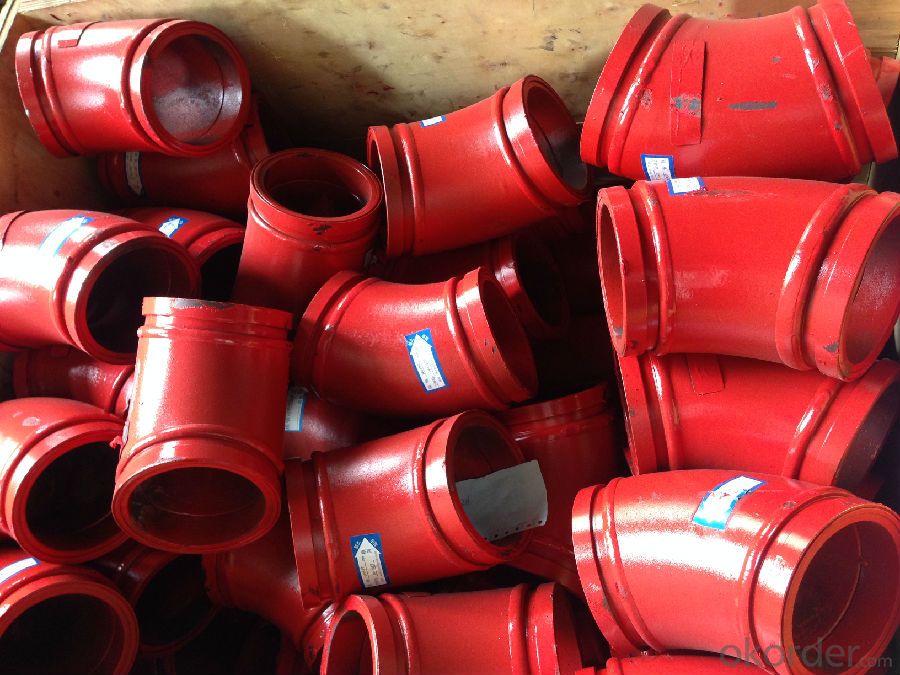
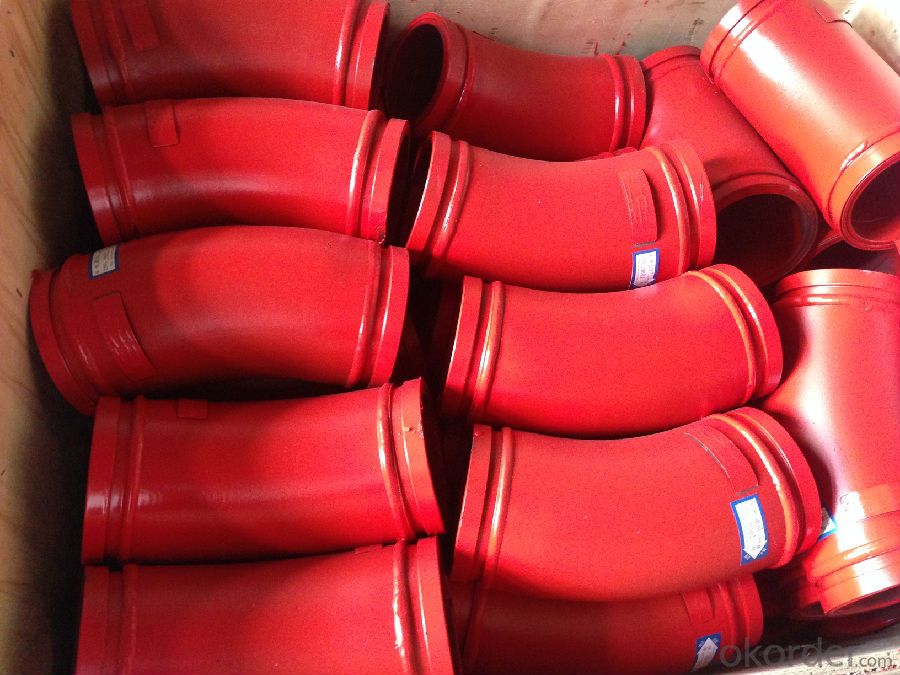
- Q: Are there any safety considerations when using concrete pump spare parts?
- Yes, there are several safety considerations that should be taken into account when using concrete pump spare parts. Firstly, it is important to ensure that the spare parts are of high quality and are compatible with the specific make and model of the concrete pump. Using substandard or incorrect spare parts can lead to equipment failure, which can be dangerous for the operator and those working in the vicinity. Additionally, proper maintenance and inspection of the spare parts is crucial for safety. Regularly inspecting the parts for any signs of wear or damage can help identify potential issues before they cause accidents or equipment failure. It is also important to follow the manufacturer's guidelines for maintenance and replacement intervals. When using concrete pump spare parts, it is essential to follow all safety procedures and protocols. This includes wearing appropriate personal protective equipment (PPE), such as safety goggles, gloves, and steel-toed boots. It is also important to ensure that all operators are trained in the proper use of the equipment and understand the potential hazards involved. Furthermore, it is crucial to follow safe operating practices when using concrete pump spare parts. This includes maintaining a safe distance from the working area, ensuring that the concrete pump is stable and secure, and avoiding overloading or exceeding the recommended operating capacity. By considering these safety considerations and following proper procedures, the risks associated with using concrete pump spare parts can be minimized, ensuring the safety of operators and those working on the construction site.
- Q: Can concrete pump spare parts be customized for specific pump models?
- Customization of concrete pump spare parts is possible for specific pump models. Concrete pumps are available in various sizes and designs, and each model may have distinct specifications and requirements for its spare parts. To ensure compatibility and achieve optimal performance, it is essential to customize the spare parts according to the particular pump model. This customization may involve adjusting dimensions, materials, and other technical specifications to suit the specific pump model. By customizing the spare parts, a perfect fit is ensured, and the efficiency and longevity of the concrete pump are improved. Furthermore, customization allows for potential enhancements or modifications to the original design, resulting in superior performance and durability of the pump. Therefore, it is vital to collaborate with reputable manufacturers or suppliers who can provide customized concrete pump spare parts for specific pump models.
- Q: How often should a concrete pump cleaning ball be used?
- To guarantee the cleanliness and optimal operation of the pump, it is necessary to employ a concrete pump cleaning ball after each pumping task or at the very least, on a daily basis. This cleaning ball aids in the elimination of any residue or particles that might have amassed within the pump and its conduits during the pumping procedure. Consistently utilizing a cleaning ball prevents the occurrence of obstructions and hindrances, thereby ensuring a seamless and effective pumping operation.
- Q: Can concrete pump spare parts be resold or traded in for new parts?
- Yes, concrete pump spare parts can be resold or traded in for new parts. Depending on the condition and demand for the specific parts, reselling them can be a viable option to recover some of the initial investment. There are various platforms, both online and offline, where individuals or businesses can sell their used concrete pump spare parts. Additionally, some manufacturers or distributors may offer trade-in programs where old parts can be exchanged for new ones, providing customers with a cost-effective way to upgrade their equipment. However, the resale value or trade-in options may vary depending on factors such as the age, condition, and market demand for the specific spare parts.
- Q: How often should concrete pump hydraulic oil coolers be inspected and maintained?
- To guarantee optimal performance and avoid possible problems, it is necessary to carry out regular inspections and maintenance on the hydraulic oil coolers of concrete pumps. The frequency of these procedures will vary depending on factors such as the pump's operating conditions, workload, and the recommendations provided by the manufacturer. As a general rule, it is advisable to inspect and maintain the concrete pump hydraulic oil coolers at least once every six months or every 500-700 operating hours, whichever comes first. However, in more demanding or extreme operating conditions, it may be necessary to perform these tasks more frequently. During these inspections, it is of utmost importance to thoroughly clean the cooler and examine it for any signs of damage, corrosion, or leaks. It is also crucial to inspect the cooler's fins for any blockages, as the presence of debris or dirt can decrease its efficiency. Regularly checking and replacing the air filters of the cooler is equally important to ensure proper airflow and prevent overheating. In terms of regular maintenance, it is vital to replace the hydraulic oil and filters according to the manufacturer's recommendations. This action helps maintain the oil's viscosity and prevents any contaminants from causing damage to the cooler or other hydraulic components. To summarize, conducting regular inspections and maintenance on concrete pump hydraulic oil coolers is crucial to ensure efficient operation and prolong their lifespan. By adhering to the manufacturer's guidelines and taking into account specific operating conditions, it is possible to determine the appropriate frequency for these inspections and maintenance tasks.
- Q: What are the different sizes of concrete pump pipes available?
- The sizes of concrete pump pipes typically range from 2 inches to 6 inches in diameter.
- Q: How often should concrete pump booms be inspected and maintained?
- To ensure the safe and efficient operation of concrete pump booms, it is important to inspect and maintain them regularly. The frequency of these inspections and maintenance tasks will depend on how often and under what conditions the boom is used. Generally, it is recommended to inspect and maintain the boom at least once a month or after every 250 pumping hours, whichever comes first. During these inspections, it is crucial to carefully examine the boom for any signs of wear and tear, damage, or malfunctioning parts. The hydraulic system, including the hoses, cylinders, and valves, should be thoroughly inspected and tested for leaks, blockages, or malfunctions. Additionally, the structural integrity of the boom, such as the main boom, articulation points, and outriggers, should be checked for cracks, deformations, or signs of stress. Regular maintenance of the concrete pump boom should include cleaning and lubricating all movable parts, checking and adjusting the tension of the cables, belts, and chains, and replacing any worn-out or damaged components. It is also important to inspect and test the electrical and control systems to ensure proper functioning. In addition to regular inspections and maintenance, it is crucial to follow the manufacturer's guidelines and recommendations for specific maintenance intervals and procedures. Depending on the level of usage, working conditions, and any changes in performance or operation, it may be necessary to conduct more frequent inspections and maintenance. By conducting regular inspections and maintenance, concrete pump boom owners can reduce the risk of accidents, extend the lifespan of the equipment, and ensure optimal performance. It is always advisable to consult with the manufacturer or a qualified professional to determine the most suitable inspection and maintenance schedule for a specific concrete pump boom.
- Q: What is the function of a concrete pump hopper grate clamp?
- A concrete pump hopper grate clamp is designed to securely hold the grate in place on the hopper, preventing it from shifting or becoming dislodged during the concrete pumping process.
- Q: What are the different types of concrete pump hopper screens?
- There is a wide range of hopper screens available for concrete pumps, each designed to meet specific needs and requirements. 1. The wire mesh screen is the most commonly used type. It is made of woven wire mesh and prevents large debris or aggregates from entering the pump system. These screens come in various sizes and can be easily replaced when worn or damaged. 2. Perforated plate screens are made of solid metal plates with small holes or perforations. They are particularly effective in preventing fine particles or sediments from entering the pump system. Perforated plate screens are more durable than wire mesh screens and can withstand heavy-duty applications. 3. Polyurethane screens are made of polyurethane material, which has excellent resistance to abrasion and wear. These screens are commonly used in high-performance concrete pumps that handle abrasive materials. They are highly durable and can be easily cleaned or replaced when necessary. 4. Some concrete pump hoppers are equipped with a vibrating screen, which separates and removes solids or debris from the concrete mixture. The vibrating screen uses vibration to facilitate the separation process, ensuring a cleaner and more consistent concrete flow. 5. Self-cleaning screens are designed with a mechanism that prevents clogging and maintains an uninterrupted concrete flow. These screens, usually made of wire mesh or perforated plate, use mechanical or pneumatic methods to automatically remove debris from the screen surface. When selecting a hopper screen, it is crucial to consider the specific requirements of your concrete pumping operation. Factors such as aggregate size, presence of fine particles, and abrasiveness should be taken into account to ensure optimal performance and longevity.
- Q: How can a malfunctioning control panel affect the pump's operation?
- The operation of a pump can be negatively affected by a control panel that is not functioning properly. Firstly, the control panel is responsible for monitoring and controlling various functions of the pump, including starting, stopping, and regulating the flow of fluids. If the control panel malfunctions, it may not send accurate signals to the pump, resulting in erratic or incorrect operation. Furthermore, a malfunctioning control panel can cause a breakdown in communication between the pump and other components or systems. For example, if the control panel fails to transmit important information to the pump's sensors or other control devices, the pump may not be able to respond appropriately to changes in pressure, temperature, or flow rate. This can lead to inefficient performance, potential damage to the pump, or even complete failure. Moreover, the safety of the pump's operation can be compromised by a malfunctioning control panel. Control panels often include safety features such as emergency shutdowns or alarms to prevent hazardous situations. If these safety mechanisms are compromised due to a malfunction, it can increase the risk of accidents, equipment damage, or harm to personnel. In conclusion, a malfunctioning control panel can disrupt the proper functioning of a pump by causing operational inconsistencies, loss of communication with other components, decreased efficiency, increased risk of accidents, and potential damage to the pump itself. Therefore, it is essential to regularly inspect and maintain control panels to ensure they function properly and minimize the chances of any negative impact on the pump's operation.
Send your message to us
Concrete Pumps Spare Parts Elbow Double Wall 45DEG R275
- Loading Port:
- Tianjin
- Payment Terms:
- TT OR LC
- Min Order Qty:
- 20 pc
- Supply Capability:
- 1000 pc/month
OKorder Service Pledge
OKorder Financial Service
Similar products
Hot products
Hot Searches
Related keywords
